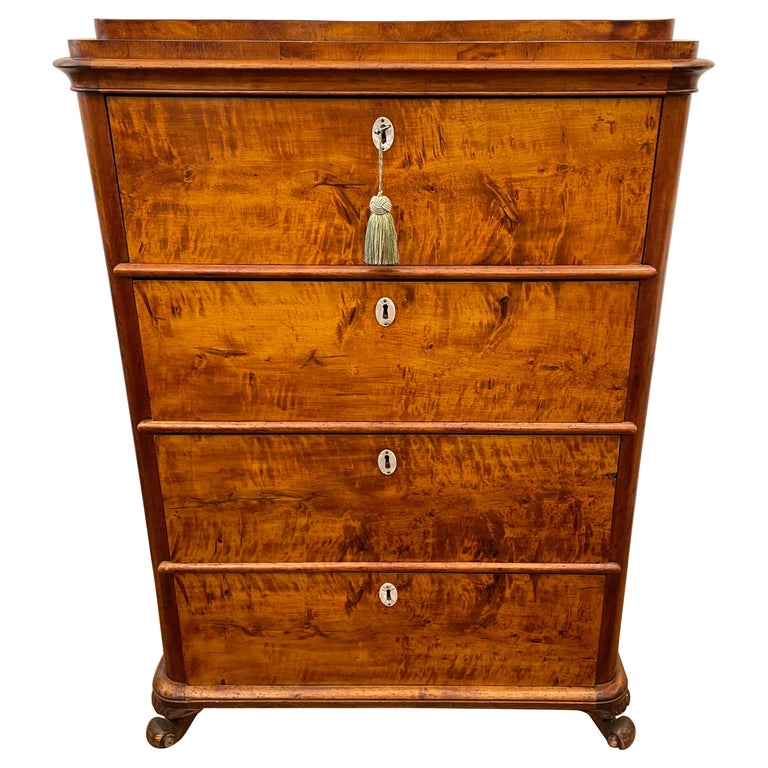Eileen Lane Antiques
Biedermeier Chest of Drawers with Mother of Pearl Eschoens
Biedermeier Chest of Drawers with Mother of Pearl Eschoens
Couldn't load pickup availability
This strong chest of drawers gracefully creates storage while maintaining natural beauty. The emphasis has been kept upon clean lines and minimal ornamentation consistent with basis of Biedermeier in utilitarian principles. The top drawer has the original bespoke organizational system while the other drawers have deep drawer storage. Practical and elegant, this chest of drawers is perfect for any space.
-
Dimensions:
Height: 45 in. (114.3 cm)
Width: 32 in. (81.28 cm)
Depth: 17.5 in. (44.45 cm)
-
Style:
Biedermeier (Of the Period)
-
Materials and Techniques:
Birch, Hand-Crafted
-
Place of Origin:
Europe, Sweden
-
Period:
1830-1839
-
Date of Manufacture:
1830
-
Condition:
Good; Wear consistent with age and use.
Biedermeier was an influential German style of furniture design that evolved from 1815–1848. The period extended into Scandinavia, as disruptions due to numerous states that made up the German nation were not unified by rule from Berlin until 1871. These post-Biedermeier struggles, influenced by historicism, created their own styles. As the period progressed, however, the style moved from the early rebellion against Romantic-era fussiness to increasingly ornate commissions by a rising middle class, eager to show their newfound wealth. The idea of clean lines and utilitarian postures would resurface in the 20th century, continuing into the present day. Middle to late-Biedermeier furniture design represented a heralding towards historicism and revival eras long sought for. Social forces originating in France would change the artisan-patron system that achieved this period of design, first in the German states, and then into Scandinavia. The middle class growth originated in the Industrial Revolution in Britain and many Biedermeier designs owe their simplicity to Georgian lines of the 19th century, as the proliferation of design publications reached the loose German states and Austria-Hungary.
The Biedermeier style was a simplified interpretation of the influential French Empire style of Napoleon I, which introduced the romance of ancient Roman Empire styles, adapting these to modern early 19th century households. Biedermeier furniture used locally available materials such as cherry, ash, and oak woods rather than the expensive timbers such as fully imported mahogany. Whilst this timber was available near trading ports such as Antwerp, Hamburg, and Stockholm, it was taxed heavily whenever it passed through another principality. This made mahogany very expensive to use and much local cherry and pearwood was stained to imitate the more expensive timbers. Stylistically, the furniture was simple and elegant.
Many unique designs were created in Vienna, primarily because a young apprentice was examined on his use of material, construction, originality of design, and quality of cabinet work, before being admitted to the league of approved master cabinetmakers. Furniture from the earlier period (1815–1830) was the most severe and neoclassical in inspiration. It also supplied the most fantastic forms which the second half of the period (1830–1848) lacked, being influenced by the many style publications from Britain. Biedermeier furniture was the first style in the world that emanated from the growing middle class. It preceded Victoriana and influenced mainly German-speaking countries. In Sweden, Jean-Baptiste Bernadotte, whom Napoleon appointed as ambassador to Sweden to sideline his ambitions, abandoned his support for Napoleon in a shrewd political move. Later, after being adopted by the King of Sweden (who was childless), he became Sweden's new king as Karl XIV Johan. The Swedish Karl Johan style, similar to Biedermeier, retained its elegant and blatantly Napoleonic style throughout the 19th century.
Share










